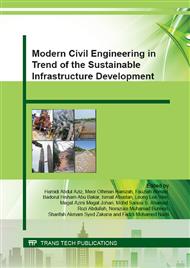p.345
p.351
p.357
p.363
p.369
p.375
p.381
p.387
p.393
The Alternative Trip Generation Model for Flat/Apartment/Condominium and Low Cost Housing Subcategories
Abstract:
Malaysian Trip Generation Manual (MTGM) is an important document to assist transport planners in forecasting the estimated trip attraction and trip production from a land use. The forecast is crucial in estimating trip generation from a proposed development on the existing road network. Therefore, this study is to verify the accuracy of the existing trip generation model published in MTGM for flat/apartment/condominium and low cost housing subcategories. By applying variable transformation, four alternative models were developed. They were the logarithmic model, the inverse model, the linear-logarithmic model and the logarithmic-linear model. Using residual analysis, influential data was identified and taken out for second analysis. Model selection was based on R2 value, t-test and Kolmogorov-Smirnov test results. Besides linear model, logarithmic model is also truly representing trip generation model for both subcategories. There is some difference in the trip generation estimation between the study model and the existing model in MTGM. Sensitivity analysis shows the level of sensitivity between study model and existing linear model. One of the implications in using the studied trip generation model is in evaluating level of service of the junction.
Info:
Periodical:
Pages:
369-374
Citation:
Online since:
October 2015
Price:
Сopyright:
© 2015 Trans Tech Publications Ltd. All Rights Reserved
Share:
Citation:


